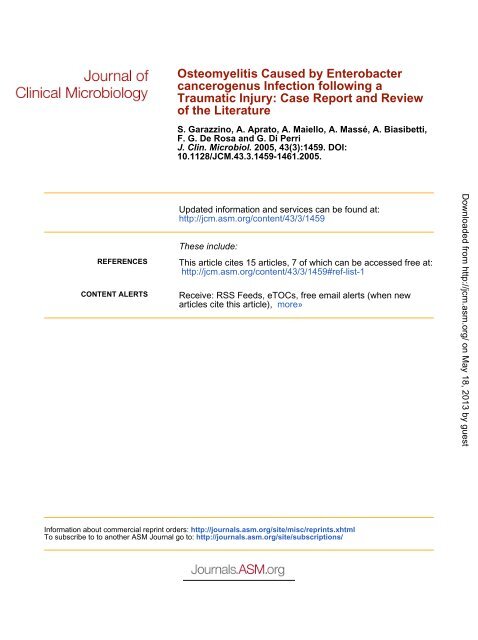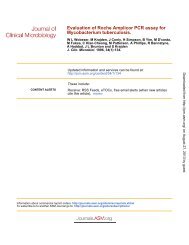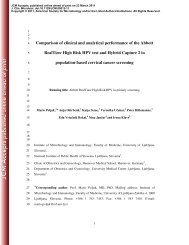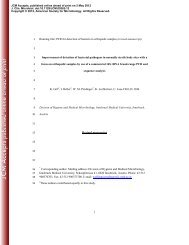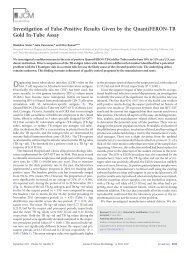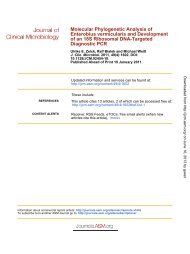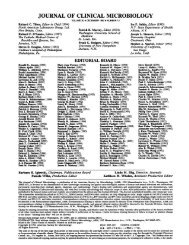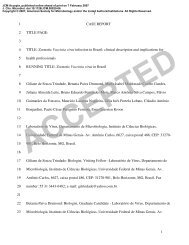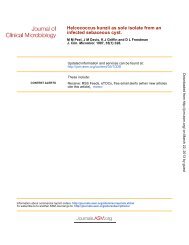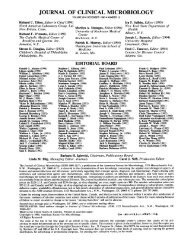Osteomyelitis Caused by Enterobacter cancerogenus Infection ...
Osteomyelitis Caused by Enterobacter cancerogenus Infection ...
Osteomyelitis Caused by Enterobacter cancerogenus Infection ...
You also want an ePaper? Increase the reach of your titles
YUMPU automatically turns print PDFs into web optimized ePapers that Google loves.
REFERENCES<br />
CONTENT ALERTS<br />
<strong>Osteomyelitis</strong> <strong>Caused</strong> <strong>by</strong> <strong>Enterobacter</strong><br />
<strong>cancerogenus</strong> <strong>Infection</strong> following a<br />
Traumatic Injury: Case Report and Review<br />
of the Literature<br />
S. Garazzino, A. Aprato, A. Maiello, A. Massé, A. Biasibetti,<br />
F. G. De Rosa and G. Di Perri<br />
J. Clin. Microbiol. 2005, 43(3):1459. DOI:<br />
10.1128/JCM.43.3.1459-1461.2005.<br />
Updated information and services can be found at:<br />
http://jcm.asm.org/content/43/3/1459<br />
These include:<br />
This article cites 15 articles, 7 of which can be accessed free at:<br />
http://jcm.asm.org/content/43/3/1459#ref-list-1<br />
Receive: RSS Feeds, eTOCs, free email alerts (when new<br />
articles cite this article), more»<br />
Information about commercial reprint orders: http://journals.asm.org/site/misc/reprints.xhtml<br />
To subscribe to to another ASM Journal go to: http://journals.asm.org/site/subscriptions/<br />
Downloaded from<br />
http://jcm.asm.org/<br />
on May 18, 2013 <strong>by</strong> guest
JOURNAL OF CLINICAL MICROBIOLOGY, Mar. 2005, p. 1459–1461 Vol. 43, No. 3<br />
0095-1137/05/$08.000 doi:10.1128/JCM.43.3.1459–1461.2005<br />
Copyright © 2005, American Society for Microbiology. All Rights Reserved.<br />
<strong>Osteomyelitis</strong> <strong>Caused</strong> <strong>by</strong> <strong>Enterobacter</strong> <strong>cancerogenus</strong> <strong>Infection</strong> following<br />
a Traumatic Injury: Case Report and Review of the Literature<br />
S. Garazzino, 1 * A. Aprato, 2 A. Maiello, 1 A. Massé, 2 A. Biasibetti, 2 F. G. De Rosa, 1 and G. Di Perri 1<br />
Department of Infectious Diseases 1 and Orthopaedic Centre and Traumatologic Hospital, 2 University of Turin, Turin, Italy<br />
Received 28 August 2004/Returned for modification 17 October 2004/Accepted 9 November 2004<br />
We report a case of osteomyelitis caused <strong>by</strong> <strong>Enterobacter</strong> <strong>cancerogenus</strong> resistant to aminopenicillins in a<br />
56-year-old male who had a motorcycle accident and suffered from multiple bone fractures with abundant<br />
environmental exposure. E. <strong>cancerogenus</strong> has rarely been associated with human infections, and its clinical<br />
significance remains unclear.<br />
CASE REPORT<br />
A previously healthy 56-year-old lawyer had a severe motorcycle<br />
accident, in which he was thrown onto the ground. He<br />
suffered from an open fracture of the proximal third of the<br />
right leg, a right acromioclavicular (AC) luxation and multiple<br />
fractures in other body parts.<br />
He immediately underwent surgery with reduction and external<br />
fixation of the open tibial fracture. A single dose of<br />
cefamandole (2 g) given intravenously (i.v.) was administered<br />
as prophylaxis at the time of anesthesia. Empirical therapy with<br />
amoxicillin-clavulanic acid (2.2 g given i.v. every 8 h) and metronidazole<br />
(500 mg given i.v. every 8 h) was introduced, starting<br />
from the day following the intervention. A week later,<br />
another surgery was performed in order to reduce the AC<br />
luxation and to insert an external fixator on the right ulna.<br />
Metronidazole therapy was stopped after 2 weeks.<br />
Four weeks after admission, while on continued antibiotic<br />
treatment with amoxicillin-clavulanic acid, the patient started<br />
complaining of increasing leg pain, with concomitant appearance<br />
of spontaneous purulent drainage from the wound on the<br />
anterior tibial side. The patient remained apyretic with normal<br />
white blood cells, an erythrocyte sedimentation rate of 38<br />
mm/h, C-reactive protein level of 8.2 mg/liter (normal values, 0<br />
to 5 mg/liter), and fibrinogen level of 445 mg/dl. An X-ray of<br />
the right leg showed that the fracture had not healed.<br />
A swab culture of the purulent wound grew <strong>Enterobacter</strong><br />
<strong>cancerogenus</strong> resistant to aminopenicillins (in the presence or<br />
absence of -lactamase inhibitor) and to cefazoline: amoxicillin-clavulanic<br />
acid was therefore stopped, and a new antibiotic<br />
regimen consisting of levofloxacin (500 mg given i.v. once a<br />
day) plus ceftriaxone (2 g given i.v. once a day) was chosen on<br />
the basis of the susceptibility tests.<br />
At the end of the fifth week, the patient underwent extensive<br />
debridement with resection of infected and necrotic-appearing<br />
areas of the tibial bone. An Ilizarov ring fixator was positioned.<br />
E. <strong>cancerogenus</strong> was cultured again from the bone specimens<br />
collected during the operation. The resistance pattern was unchanged<br />
from that of the previous isolate, and no change in<br />
* Corresponding author. Mailing address: Department of Infectious<br />
Diseases, University of Turin, Ospedale Amedeo di Savoia, Corso<br />
Svizzera 164, Turin 10149, Italy. Phone: 39 011 4393926. Fax: 39 011<br />
4393977. E-mail: silvia.garazzino@inwind.it.<br />
1459<br />
antibiotic treatment was required. In the following days, the<br />
rapid recovery of the lesion allowed the uneventful application<br />
of a skin graft. An X-ray showed an overt tendency toward<br />
healing, with newly formed bone tissue seen at the site of fracture.<br />
Inflammatory markers returned to values in the normal<br />
range.<br />
The patient was discharged after 7 weeks of i.v. treatment<br />
with levoxacin and ceftriaxone.<br />
The National Nosocomial <strong>Infection</strong>s Surveillance system in<br />
the United States recently reported that nosocomial infections<br />
caused <strong>by</strong> <strong>Enterobacter</strong> spp. are increasing and a matter of<br />
concern (8). This trend has been confirmed all over Europe in<br />
the last several years, with <strong>Enterobacter</strong> spp. accounting for 8%<br />
of the microorganisms isolated from intensive care units (15).<br />
At this time, there are 13 recognized species in the genus<br />
<strong>Enterobacter</strong>. <strong>Enterobacter</strong> cloacae and <strong>Enterobacter</strong> aerogenes<br />
are routinely isolated from human clinical specimens, while the<br />
other species are mostly isolated from environmental or vegetal<br />
sources (5). <strong>Enterobacter</strong> <strong>cancerogenus</strong> is one of the five<br />
new species identified over the last few years. Originally designated<br />
enteric group 19 and first ascribed to the genus Erwinia,<br />
it has been transferred to the genus <strong>Enterobacter</strong> as a<br />
senior synonym of <strong>Enterobacter</strong> taylorae when extensive taxonomic<br />
investigations revealed its genetic identity to a microorganism<br />
identified <strong>by</strong> Urosĕvić in 1966 and named Erwinia cancerogena<br />
(6). E. <strong>cancerogenus</strong> is a lactose-fermenting rod. E.<br />
<strong>cancerogenus</strong> has a DNA relatedness of 61% to E. cloacae and<br />
differs from it mostly <strong>by</strong> being ornithine decarboxylase negative<br />
and D-arabinose positive.<br />
E. <strong>cancerogenus</strong> exhibits natural resistance to aminopenicillins<br />
(i.e., amoxicillin and amoxicillin-clavulanic acid) and/or to<br />
narrow- and expanded-spectrum cephalosporins (i.e., cefaclor,<br />
cefazoline, loracarbef, and cefoxitin). The -lactam phenotype<br />
of E. <strong>cancerogenus</strong> is similar to that expressed <strong>by</strong> other wellknown<br />
<strong>Enterobacter</strong> spp. and indicates the presence of chromosomally<br />
encoded AmpC -lactamases (Amber class C -lactamases)<br />
(3, 12, 14).<br />
In agreement with our finding, Pitout et al. found inducible<br />
AmpC -lactamases in all E. <strong>cancerogenus</strong> strains examined<br />
(n 6), with isoelectric point (pI) values of 9, suggesting an<br />
enzyme similar to those found in the same study in wild-type<br />
Downloaded from<br />
http://jcm.asm.org/<br />
on May 18, 2013 <strong>by</strong> guest
1460 CASE REPORTS J. CLIN. MICROBIOL.<br />
TABLE 1. Review of E. <strong>cancerogenus</strong> infections in humans reported in the literature<br />
Antibiotic treatment Outcome<br />
Case description a<br />
No. of<br />
patients<br />
Researchers and<br />
reference<br />
Yr<br />
1987 Westblom and Coggins (16) 1 <strong>Osteomyelitis</strong> of the femur in a 18-yr-old man with an open fracture Cefotaxime (2 days); cefoperazone (10 days); cefadroxil (2 Chronic infection<br />
after a motorcycle accident<br />
weeks); cefotaxime (4 weeks); cefotaxime tobramycin<br />
1989 Reina et al. (10, 11) 2 Urinary tract infection in a 70-yr-old adult with urinary lithiasis NA b<br />
NA<br />
<strong>Infection</strong> of a traumatic cranial wound (car crash) in a 36-yr-old man NA NA<br />
1993 Rubinstien et al. (13) 4 Bacteremia and pneumonia in a 75-yr-old man with left ventricular heart Ceftriaxone (7 days); ceftazidime vancomycin (4 days); Died<br />
dysfunction<br />
tobramycin vancomycin (4 days)<br />
Bacteremia, cholangitis, and pneumonia in a 75-yr-old man with<br />
Cefotetan metronidazole (3 days); trimethoprim-sulfa- Died<br />
adenocarcinoma of the gallbladder<br />
methoxazole (8 days); ciprofloxacin (10 days)<br />
Urinary tract infection in a 75-yr-old female with carcinoma of the pancreas Ampicillin (3 days); ceftazidime tobramycin Died<br />
Urinary tract infection in a 85-yr-old man with benign prostatic<br />
Cefuroxime (2 days); clindamycin (2 days); trimethoprim- Recovered<br />
hypertrophy and heart disease<br />
sulfamethoxazole<br />
1994 Martinez et al. (7) 3 Two cases of E. <strong>cancerogenus</strong> infection of an open wound NA NA<br />
One nosocomial bacteremia following prolonged hospitalization NA NA<br />
1997 Abbott and Janda (2) 5 <strong>Infection</strong> of the hand after traumatic cut Cephradine Healed<br />
<strong>Infection</strong> of the right forearm after open fracture and reduction with Cephradine, gentamicin sulfate Recovered<br />
plates and screws<br />
Crushing injury of the left thigh and fracture of the left hip; infected NA NA<br />
hematoma after surgical treatment<br />
Multiple trauma with multiple fractures, bacteremia and neck abscess Tobramycin sulfate NA<br />
surrounding orthopedic hardware<br />
Multiple trauma with skeletal damage and intracranial injury; infection Multiple aminoglycosides; penicillin NA<br />
of a cutdown site in the right safenous vein<br />
a Most cases have common features: traumatic wounds with environmental source of infection, E. <strong>cancerogenus</strong> isolates resistant to aminopenicillin, initial antibiotic treatment often ineffective, multiple antibiotic<br />
regimens, and difficult resolution of infection.<br />
b NA, not available.<br />
strains of E. cloacae complex (pIs 8.0 to 9) and E. aerogenes<br />
(pIs 8.4 to 8.8) (9).<br />
The constitutive hyperproduction of AmpC is of major concern,<br />
since it confers resistance to most -lactam antibiotics,<br />
sparing only carbapenems and, amongst cephalosporins, only<br />
cefepime. This phenotype commonly results from selective<br />
antibiotic pressure, and <strong>Enterobacter</strong> isolates resistant to expanded-spectrum<br />
cephalosporins are becoming a matter of<br />
concern for the possibility of transmitting antibiotic resistance<br />
from one microorganism to another worldwide. Outbreaks of<br />
infections due to Klebsiella pneumoniae harboring plasmidencoded<br />
cephalosporinases and the spread of this resistance<br />
mechanism to bacterial species naturally susceptible to cephamycins<br />
have been reported (4).<br />
So far, E. <strong>cancerogenus</strong> has been rarely found associated with<br />
human infections, and only a few cases of acute or chronic<br />
illnesses have been identified: E. <strong>cancerogenus</strong> infections seem<br />
to occur mostly in the setting of contaminated wounds, even if<br />
other exposures have been reported (Table 1).<br />
The aim of our brief report is primarily to contribute to the<br />
understanding of E. <strong>cancerogenus</strong> infections, to the knowledge<br />
of the epidemiology, clinical manifestations, and therapeutic<br />
options. In this case, the history of an open fracture following<br />
a crush injury suggests an environmental, rather than nosocomial,<br />
source of the organism: indeed, E. <strong>cancerogenus</strong> is generally<br />
recovered from environmental or vegetal sources and is<br />
considered mostly phytopathogenic (1). Our strain displayed<br />
an antibiotic susceptibility pattern similar to previously reported<br />
patterns (10, 11, 13, 16) and was capable of causing the<br />
same morbidity as other <strong>Enterobacter</strong> spp. or gram-negative<br />
bacteria that cause acute osteomyelitis. Note that this patient<br />
had an inappropriate 4-week antibiotic therapy administered<br />
before E. <strong>cancerogenus</strong> grew in culture from a swab and the in<br />
vitro susceptibility test was available. In conclusion, we suggest<br />
that an E. <strong>cancerogenus</strong> infection should be considered in patients<br />
with traumatic injuries and secondary infection with a<br />
microorganism identified as an <strong>Enterobacter</strong> species, especially<br />
when treatment with aminopenicillin is unsuccessful or when<br />
wound environmental contamination is plausible.<br />
REFERENCES<br />
1. Abbott, S. 1999. Klebsiella, <strong>Enterobacter</strong>, Citrobacter, and Serratia, p. 475–480.<br />
In P. R. Murray, E. J. Baron, M. A. Pfaller, F. C. Tenover, and R. H. Yolken<br />
(ed.), Manual of clinical microbiology, 7th ed. ASM Press, Washington, D.C.<br />
2. Abbott, S. L., and J. M. Janda. 1997. <strong>Enterobacter</strong> <strong>cancerogenus</strong> (“<strong>Enterobacter</strong><br />
taylorae”) infections associated with severe trauma or crush injuries.<br />
Am. J. Clin. Pathol. 107:359–361.<br />
3. Ambler, R. P. 1980. The structure of L-lactamases. Philos. Trans. R. Soc.<br />
Lond. B 289:321–331.<br />
4. Bradford, P. A., C. Urban, N. Mariano, S. J. Projan, J. J. Rahal, and K.<br />
Bush. 1997. Imipenem resistance in Klebsiella pneumoniae is associated with<br />
the combination of ACT-1, a plasmid-mediated AmpC beta-lactamase, and<br />
the loss of an outer membrane protein. Antimicrob. Agents Chemother.<br />
41:563–569.<br />
5. Dickey, R. S., and C. H. Zummoff. 1988. Emended description of <strong>Enterobacter</strong><br />
<strong>cancerogenus</strong> comb. nov. (formerly Erwinia cancerogena). Int. J. Syst.<br />
Bacteriol. 38:371–374.<br />
6. Farmer, J. J., III, G. R. Fanning, B. R. Davis, C. M. O’Hara, C. Riddle, F. W.<br />
Hickman-Brenner, M. A. Asbury, V. A. Lowery III, and D. J. Brenner. 1985.<br />
Escherichia fergusonii and <strong>Enterobacter</strong> taylorae, two new species of <strong>Enterobacter</strong>iaceae<br />
isolated from clinical specimens. J. Clin. Microbiol. 21:77–81.<br />
7. Martinez, J., M. Toval, and L. F. Colomo. 1994. 3 new cases of <strong>Enterobacter</strong><br />
taylorae infection. Enferm. Infecc. Microbiol. Clin. 12:289–292.<br />
8. National Nosocomial <strong>Infection</strong>s Surveillance System. 2003. National Nosocomial<br />
<strong>Infection</strong>s Surveillance (NNIS) System report. Data summary from<br />
January 1992 through June 2003, issued August 2003. Am. J. Infect. Control<br />
31:481–498.<br />
Downloaded from<br />
http://jcm.asm.org/<br />
on May 18, 2013 <strong>by</strong> guest
VOL. 43, 2005 CASE REPORTS 1461<br />
9. Pitout, J. D., E. S. Moland, C. C. Sanders, K. S. Thomson, and S. R.<br />
Fitzsimmons. 1997. -Lactamases and detection of -lactam resistance in<br />
<strong>Enterobacter</strong> spp. Antimicrob. Agents Chemother. 41:35–39.<br />
10. Reina, J., F. Salva, J. Gil, and P. Alomar. 1989. Urinary tract infection<br />
caused <strong>by</strong> <strong>Enterobacter</strong> taylorae. J. Clin. Microbiol. 27:2877.<br />
11. Reina, J., and P. Alomar. 1989. <strong>Enterobacter</strong> taylorae wound infection. Clin.<br />
Microbiol. Newsl. 11:134–135.<br />
12. Rottman, M., Y. Benzerara, B. Hanau-Bercot, C. Bizet, A. Philippon, and G.<br />
Arlet. 2002. Chromosomal ampC genes in <strong>Enterobacter</strong> species other than<br />
<strong>Enterobacter</strong> cloacae, and ancestral association of ACT-1 plasmid-encoded<br />
cephalosporinase to <strong>Enterobacter</strong> asburiae. FEMS Microbiol. Lett. 210:87–92.<br />
13. Rubinstien, E. R., P. Klevjer-Anderson, C. A. Smith, M. T. Drouin, and J. E.<br />
Patterson. 1993. <strong>Enterobacter</strong> taylorae, a new opportunistic pathogen: report<br />
of four cases J. Clin. Microbiol. 31:249–254.<br />
14. Stock, I., and B. Wiedemann. 2002. Natural antibiotic susceptibility of <strong>Enterobacter</strong><br />
amnigenus, <strong>Enterobacter</strong> <strong>cancerogenus</strong>, <strong>Enterobacter</strong> gergoviae and<br />
<strong>Enterobacter</strong> sakazakii strains. Clin. Microbiol. Infect. 8:564–578.<br />
15. Verbist, L., et al. 1993. Epidemiology and sensitivity of 8625 ICU and hematology/oncology<br />
bacterial isolates in Europe. Scand J. Infect. Dis. Suppl.<br />
91:14–24.<br />
16. Westblom, T. U., and M. E. Coggins. 1987. <strong>Osteomyelitis</strong> caused <strong>by</strong> <strong>Enterobacter</strong><br />
taylorae, formerly enteric group 19. J. Clin. Microbiol. 25:2432–2433.<br />
Downloaded from<br />
http://jcm.asm.org/<br />
on May 18, 2013 <strong>by</strong> guest


